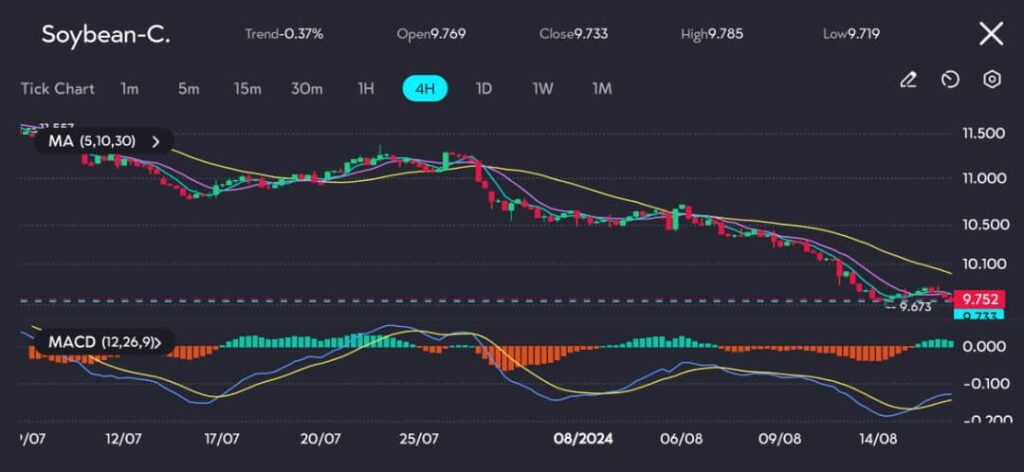Key points:
- Soybean futures have dropped 7.8% over three weeks, reflecting pressure from expected record U.S. output.
- The market is closely watching the upcoming ProFarmer Crop Tour to gauge the accuracy of yield expectations.
Soybean futures on the Chicago Board of Trade (CBOT) experienced further declines on Friday, extending a trend that has seen the market endure three consecutive weeks of losses.
As of 0149 GMT, the most-active soybean contract slid 0.2% to $9.66-1/4 per bushel, setting the stage for a weekly decline of 3.6%, the largest drop in a month. The primary driver behind this downward pressure is the growing anticipation of record U.S. soybean output, compounded by slowing demand from China, the world’s largest importer.

Picture: Soybeans trading at 9.752 on the VT Markets app.
Looking at the technicals, the 4-hour chart for Soybean-C indicates a prolonged downward trend, with the price recently closing at 9.733 after reaching a low of 9.719. The price is currently below the moving averages (MA 5, 10, 30), reflecting strong bearish momentum.
The MACD histogram shows continued negative momentum, though with signs of potential stabilization as the histogram bars are becoming shorter.
The critical support level around 9.673 is being tested, and a break below could lead to further declines. However, a bounce from this level might suggest a short-term recovery if supported by increasing volume and a crossover on the MACD.
USDA estimates heighten oversupply concerns before ProFarmer tour
The U.S. Department of Agriculture (USDA) recently increased its production estimates for both corn and soybeans, amplifying concerns about an oversupply in the global market. Traders are now carefully adjusting their positions ahead of next week’s ProFarmer Crop Tour, which is widely expected to confirm these high yield projections.
Wheat and corn prices also retreated, with wheat losing 0.1% to $5.28 per bushel and corn falling 0.5% to $3.95 per bushel. For the week, wheat has seen a decline of 2.7%, while corn remains relatively stable.
The ProFarmer Crop Tour, now in its 32nd year, will be a critical event for market participants. About 100 scouts will visit over 1,000 corn and soybean fields across key U.S. Midwest states, including Illinois, Iowa, and Nebraska, to assess yield potential.
Strong U.S. soybean export sales overshadowed by supply outlook
On the demand side, the USDA reported net weekly U.S. soybean export sales of 1,344,200 metric tons for the 2024-25 season, surpassing analysts’ expectations of 400,000 to 1,000,000 metric tons. Despite this positive export data, the overwhelming supply outlook continues to weigh on prices.
In case you missed it: Soybeans hit a four-year low amid record U.S. crop forecast
Wheat market pressured by supply, boosted by geopolitical tensions
The wheat market has been pressured by abundant supplies from the Black Sea region, though it received a slight boost from geopolitical tensions after a Russian attack on Ukrainian port infrastructure in Odesa.
The International Grains Council (IGC) also revised its global wheat production forecast for the 2024/25 season down to 799 million metric tons, a reduction from the previous estimate of 801 million tons, primarily due to lower-than-expected output in France.
In South America, Argentina’s wheat crop faces challenges from ongoing dry weather and recent cold snaps, particularly in the western farming regions. The Buenos Aires Grains Exchange has warned that these adverse conditions could further impact yields.
You might be interested: Wheat prices surge as the Russian attack on Ukraine raises supply concerns
In terms of trading activity, commodity funds were net buyers of CBOT soymeal contracts on Thursday but were net sellers of corn, soy oil, and wheat contracts. Positions in soybeans remained neutral, reflecting the market’s cautious stance amid the mixed signals from supply and demand dynamics.
Start trading now — click here to create your live VT Markets account.









